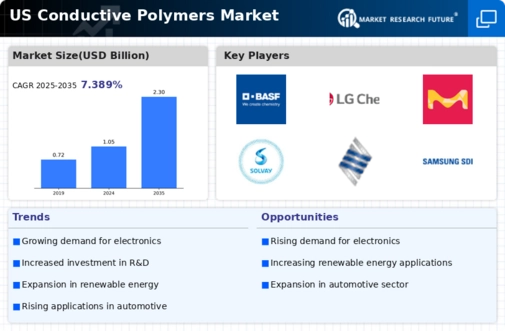The conductive polymers market is currently characterized by a dynamic competitive landscape, driven by innovation and strategic partnerships among key players. Companies such as DuPont de Nemours Inc (US), BASF SE (DE), and 3M Company (US) are at the forefront, focusing on enhancing their product offerings through advanced research and development. DuPont, for instance, emphasizes sustainability in its operations, aiming to reduce environmental impact while expanding its portfolio of conductive materials. Meanwhile, BASF is leveraging its extensive global network to optimize supply chains and enhance product accessibility, which appears to strengthen its market position. Collectively, these strategies contribute to a competitive environment that is increasingly focused on technological advancement and sustainability.
In terms of business tactics, companies are increasingly localizing manufacturing to reduce lead times and enhance responsiveness to market demands. This approach, coupled with supply chain optimization, is crucial in a market that is moderately fragmented, with several players vying for market share. The collective influence of these key players shapes a landscape where agility and innovation are paramount, allowing them to adapt to evolving customer needs and regulatory requirements.
In October 2025, 3M Company (US) announced a strategic partnership with a leading electronics manufacturer to develop next-generation conductive inks. This collaboration is expected to enhance 3M's capabilities in the rapidly growing printed electronics sector, indicating a shift towards more integrated solutions that combine traditional materials with cutting-edge technology. The strategic importance of this partnership lies in its potential to position 3M as a leader in the conductive inks market, which is anticipated to witness substantial growth in the coming years.
In September 2025, DuPont de Nemours Inc (US) launched a new line of bio-based conductive polymers aimed at reducing reliance on fossil fuels. This initiative not only aligns with global sustainability trends but also reflects DuPont's commitment to innovation in materials science. The introduction of these bio-based products could potentially attract environmentally conscious consumers and industries, thereby expanding DuPont's market reach and reinforcing its competitive edge.
In August 2025, BASF SE (DE) expanded its production capacity for conductive polymers in North America, responding to increasing demand from the automotive and electronics sectors. This expansion is strategically significant as it positions BASF to better serve its customers while enhancing its operational efficiency. By increasing local production capabilities, BASF is likely to reduce costs and improve delivery times, which could further solidify its market presence.
As of November 2025, current competitive trends in the conductive polymers market are heavily influenced by digitalization, sustainability, and the integration of artificial intelligence. Strategic alliances are becoming increasingly vital, as companies seek to leverage complementary strengths to drive innovation and market penetration. Looking ahead, it appears that competitive differentiation will evolve from traditional price-based competition to a focus on technological innovation, supply chain reliability, and sustainable practices. This shift suggests that companies that prioritize these areas may be better positioned to thrive in an increasingly complex market.


















Leave a Comment